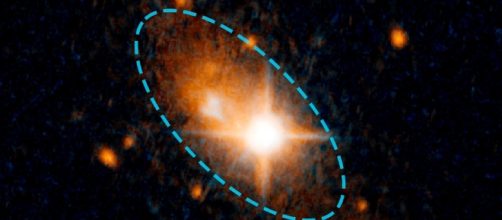This is the first time that the expulsion of a massive Black Hole (MBH) from the centre of a Galaxy has been confirmed. There had been other suspected event like this; however, the size of this black hole, which is believed to be 1 billion masses of our sun, outstands any other cases. It´s thought that the MBH could have been set out of its galaxy by the energy of gravitational waves. The event was found on a very luminous quasar (3C 186) that is located at 35,000 light years offset from the centre of a galaxy that is 8 million light years away from earth.
Quasar 3C 186
With the aid of Hubble Space Telescope, astronomers captured the image of a quasar situated not at the centre of a galaxy, as it was supposed to, but at 35,000 light years from it. Quasars are very luminous masses of gas around a black hole. While a BH cannot be detected by the naked eye, the intense luminosity created by a quasar is a sign that a black hole exists. 3C 186 is situated 8 billion light years away in a galaxy cluster; however, it was found offset from the galaxy´s centre.
What caused the black hole to be ejected from the centre of this galaxy?
Scientists believe that the expulsion of this SBH involved the energy that is equivalent to 100 million supernovas blasting at the same time and which can be produced by gravitational waves, involving the fusion of two black holes.
It´s believed that two galaxies, each with a BH at their centre, collided. The two BH at their centres rotated around each other, creating ripples of gravitational waves. When the two black holes merged into one huge BH, the energy created expulsed the new formed BH away from the centre of its galaxy.
What are gravitational waves?
These are ripples in space that are like the ripples that are created in a pond when someone throws a stone into it. Like the waves on water, ripples are created when two massive objects collide in space. Astronomers probed that gravitational waves exist when they were able to detect them using the Laser Interferometer Gravitational Wave Observatory (LIGO). The detected waves were produced by two BH which collided each other.
Astronomers intend to make further observations of this event to obtain accurate measurements of the speed and gas contents, to get a deeper understanding of the formation of these types of astronomical events.

